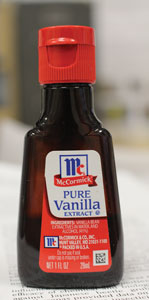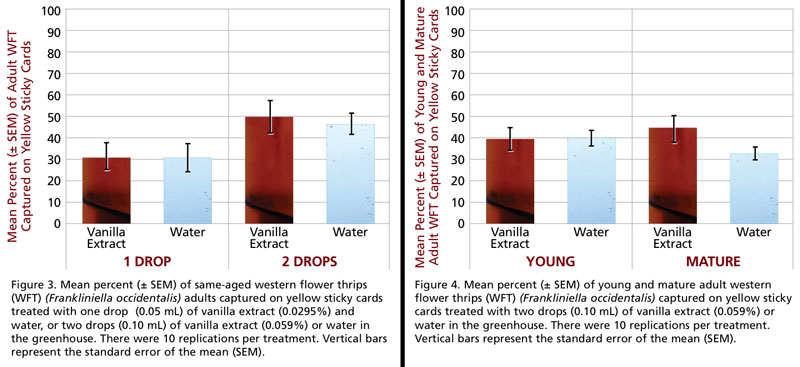9/1/2018
Do Western Flower Thrips Have a “Craving” for Vanilla?
Nathan J. Herrick & Raymond A. Cloyd

Western flower thrips, Frankliniella occidentalis, is one of the most destructive insect pests of horticultural crops, causing direct and indirect damage to plants.
Direct plant damage is associated with feeding; western flower thrips have piercing-sucking mouthparts that are used to obtain nutrients from plant cells. Their feeding results in cell death and leaf or flower deformation, which can negatively impact marketability due to decreased aesthetic value.
Indirect damage is affiliated with transmission of tospoviruses, such as Impatiens necrotic spot or Tomato spotted wilt virus that also decreases aesthetic value and marketability. Therefore, insecticides are used to suppress western flower thrips populations in greenhouse production systems.
Pictured: McCormick’s Pure Vanilla Extract was used for this experiment to see if western flower thrips are attracted to vanilla.
However, western flower thrips populations are difficult to suppress with insecticides because they inhabit secluded areas on plants, such as unopened flower buds and terminal buds, thus reducing exposure to insecticide applications. The use of colored sticky cards is oftentimes recommended as a means of monitoring for western flower thrips adults. The information garnered from monitoring helps determine population changes throughout the growing season, which also can help time insecticide applications. As such, growers regularly seek strategies that will enhance the effectiveness of monitoring techniques for western flower thrips.
Plant-derived essential oils or extracts and their subsequent volatile constituents can serve as insect attractants to enhance adult captures when used together with whole plants or when extracts are incorporated onto trapping devices. Monitoring programs can be improved by incorporating plant volatiles or extracts onto trapping devices to obtain estimates of the numbers of pests or assess presence or absence at a given time, as monitoring is usually an underestimation of the actual population.
Colored sticky cards (yellow or blue) are commonly used in greenhouses to monitor for insect pests, including western flower thrips, because they capture adults. The use of certain plant volatiles or extracts along with colored sticky cards can increase the number of western flower thrips adults captured. For example, flower volatiles, such as certain aldehydes (e.g., p-anisaldehyde), increase the number of adult western flower thrips captured on yellow sticky cards.
There are anecdotal claims that vanilla extract may be an attractant to western flower thrips; however, there’s no evidence to support these claims or explanations why vanilla extract would be attractive to western flower thrips adults. Therefore, laboratory (choice and no-choice experiments) and greenhouse experiments were conducted, using yellow sticky cards to determine whether adult western flower thrips are attracted to vanilla extract and if vanilla extract could be used to improve the accuracy of western flower thrips monitoring programs using yellow sticky cards.
Materials and methods
Laboratory experiments. Choice and no-choice experiments were designed to determine: 1) whether same-aged adult western flower thrips are attracted to vanilla extract (59% vanilla bean extract and 41% alcohol; McCormick; Figure 1); and 2) if adult western flower thrips’ age (young or mature) influences attraction to vanilla extract.
For the choice experiment, one drop (0.05 mL) of vanilla extract (0.029%) using a sterile 1 mL plastic syringe was placed into a Petri dish with western flower thrips adults added afterward. A similar method was used for the no-choice experiment, although two Petri dishes were used containing one drop (0.05 mL) of either vanilla extract (0.029%) or water. The same method was performed again using two drops (0.10 mL) of vanilla extract (0.059%). The quantity of vanilla extract used was chosen because preliminary experiments demonstrated no difference in adult western flower thrips attraction to one, two, four, five and eight drops of vanilla extract.
Another series of choice and no-choice experiments was conducted similar to that described above using one drop (0.05 mL) of vanilla extract (0.029%) or water to determine whether western flower thrips adult age influences attraction to vanilla extract or water.
Greenhouse experiments. Caged, choice experiments were conducted in a glass-covered greenhouse to determine: 1) whether same-aged adult western flower thrips exhibit similar responses in the greenhouse as in the laboratory associated with attraction to vanilla extract; and 2) if adult western flower thrips (young or mature) exhibit similar responses in the greenhouse as in the laboratory in terms of attraction to vanilla extract or water.
One yellow sticky card was attached to a bamboo stake (30.5 cm in length) using a wooden clothes pin, which kept the base of the sticky card 8.9 cm above the cage bottom. The bamboo stake was placed into a circular plastic container (250 mL) filled with sand, which held the stake upright.
One experiment was conducted using one drop (0.05 mL) of vanilla extract (0.029%) or water and subsequently repeated using two drops (0.10 mL) of vanilla extract (0.059%) or water. Two yellow sticky cards, attached to bamboo stakes, were randomly placed in opposite corners of the cages. One yellow sticky card contained vanilla extract and the other yellow sticky card contained water. A 9 dram (33 mL) plastic vial containing approximately 50 adult western flower thrips was placed in the center of each cage (26.7 cm from both sticky cards) and the number of adults captured was counted after seven days. There were 10 replications (cages) for each experiment.
A series of choice experiments was conducted similar to that described above using 2 drops (0.10 mL) of vanilla extract (0.059%) or water to determine whether age (young or mature) of adult western flower thrips respond similarly in the greenhouse as in the laboratory. Adult western flower thrips were either young or mature. Two drops were used because preliminary experiments revealed a higher number of adult western flower thrips captured than with one drop.


Results
Laboratory experiments. In the choice tests using same-aged adult western flower thrips, no selection was made within 300 seconds in the experiment with one drop (0.05 mL) of vanilla extract (0.029%) and water. However, in the no-choice tests, water was selected 60% of the time compared to 10% for vanilla extract and selection occurred in 139 ± 25.3 seconds (mean ± SEM) and 259 seconds, respectively.
Similar results were observed in the experiments using two drops (0.10 mL) of vanilla extract (0.059%) or water; however, in the choice tests, water was selected 40% of the time and vanilla extract only once or 10% of the time. Selection of water occurred in 149 ± 30.3 seconds and in 98 seconds for vanilla extract. In the no-choice tests, water was selected 30% of the time compared to 10% of the time for vanilla extract and selection occurred in 191 ± 29.7 seconds and in 48 seconds, respectively.
Experiments designed to determine if age (young or mature) of adult western flower thrips influences the amount of time in selecting vanilla extract or water didn’t reveal any significant differences in the amount of time associated with 300 seconds of exposure to vanilla extract and water among young or mature adult western flower thrips in the choice tests (or within 300 seconds of exposure to vanilla extract and water within young and mature adult western flower thrips; Figure 1).
In the no-choice tests, mature western flower thrips adults made a selection in significantly less time than young adults, although the amount of time in selecting either vanilla extract or water was not significant within adult age (young or mature; Figure 2).
Greenhouse experiments. More same-aged adult western flower thrips were captured on yellow sticky cards with two drops (0.10 mL) of vanilla extract (0.059%) or water than with one drop (0.05 mL; Figure 3). However, captures of western flower thrips adults weren’t different between yellow sticky cards treated with vanilla extract or water. Furthermore, captures of young or mature adult western flower thrips on yellow sticky cards treated with vanilla extract or water weren’t different (Figure 4). The cumulative percent of western flower thrips adults captured on the yellow sticky cards was consistent (approximately 30% to 40%) after day 2.
Discussion
This study evaluated quantitatively the anecdotal claims regarding the potential attraction of western flower thrips adults to vanilla extract. In both the laboratory and greenhouse experiments, we found no evidence that western flower thrips adults were attracted to vanilla extract.
Field experiments, such as those conducted in the greenhouse, are often more practical (realistic) in assessing insect behavior than laboratory experiments because the laboratory is an artificial environment. In addition, yellow sticky cards are commonly used in greenhouses to monitor insect pests and may act as a visual attractant to western flower thrips. However, there may be issues associated with trap distance where volatiles on baited traps may influence captures on nearby un-baited traps. However, in our study, the greenhouse experiments verified the laboratory experiments in that western flower thrips were not attracted to vanilla extract.
We were successful in recapturing between 40% and 50% of the western flower thrips adults released into our caged experiments; consequently, we were able to determine that the yellow sticky cards treated with vanilla extract were not more attractive to adults than those treated with water.
Although plant-derived essential oils or extracts and their associated volatiles can be important in managing insect pests, based on the parameters and results of our study, vanilla extract does not appear to be useful in increasing monitoring efforts or detection of western flower thrips adult populations in greenhouse crop production systems. GT
For more detailed information regarding the study please refer to the following article: N. J. Herrick, and R. A. Cloyd. 2016. “Western flower thrips, Frankliniella occidentalis (Thysanoptera: Thripidae): evaluation of potential attraction to vanilla extract under laboratory and greenhouse conditions.” HortScience 51: 525-529.
Nathan J. Herrick and Raymond A. Cloyd are with the Department of Entomology at Kansas State University in Manhattan, Kansas.